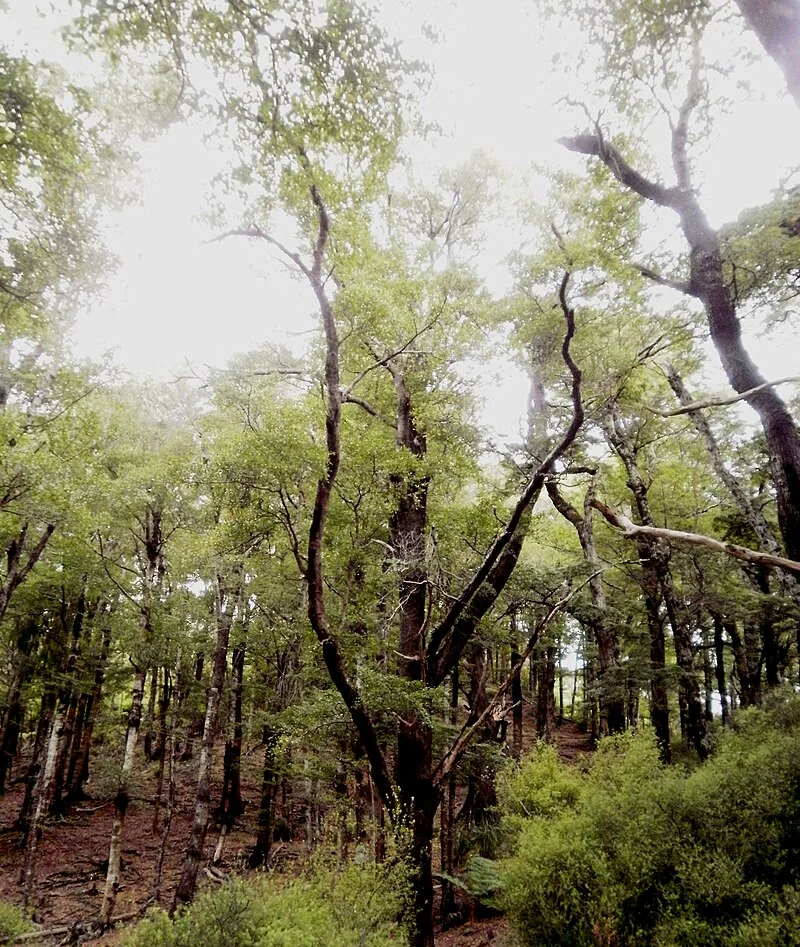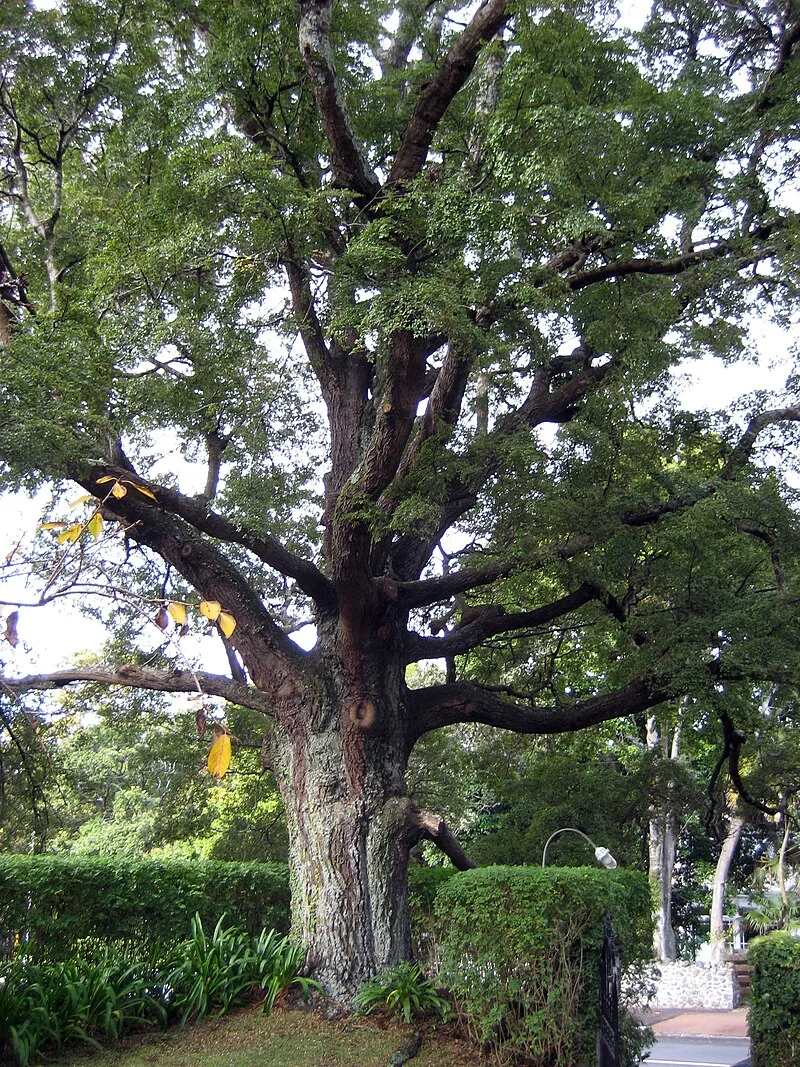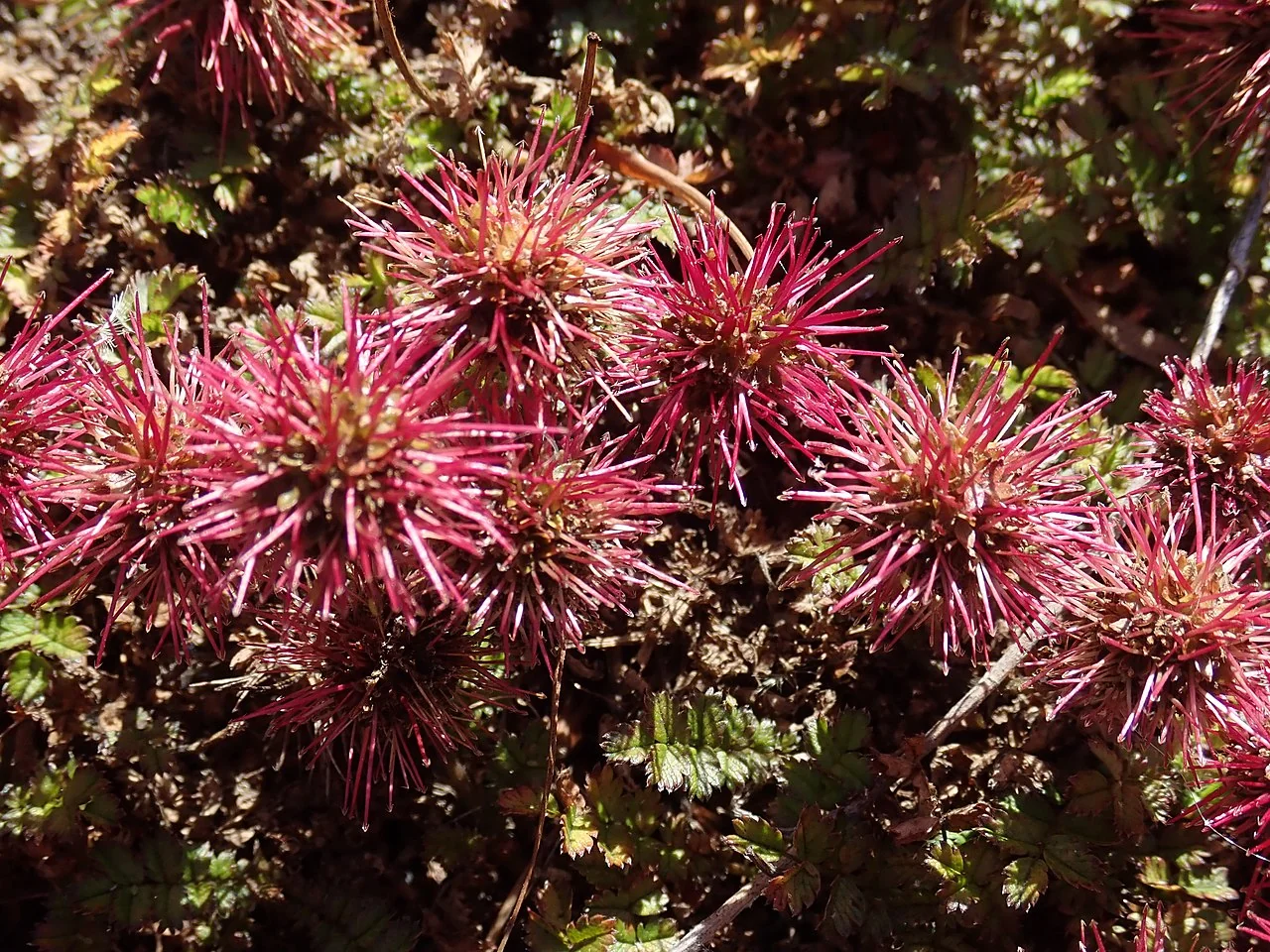
Hard Beech
Fuscospora truncata
Hard Beech, known as Tāwhairānui in te reo Māori, is a robust evergreen tree reaching 24-30 meters tall with leathery, broadly oval leaves and distinctive bark rich in tannins. Named for its extremely hard wood with high silica content, this durable species produces the finest construction timber among New Zealand's beech trees. It thrives on well-drained slopes and ridge crests, forming massive spreading crowns that create impressive specimens in New Zealand's native trees .

Plant Description
Botanical Features
Fuscospora truncata , commonly known as Hard Beech or Tāwhairānui, is a large, evergreen tree endemic to New Zealand. It typically grows 24-30 meters high, and can reach up to 36 meters in ideal conditions, with a trunk diameter of 0.6-1.2 meters. The tree develops a massive, spreading crown and often features basal flanges and root buttresses. Its distinctive features include glossy, shiny-green, leathery, oval leaves that are 13-43 mm long and 8-30 mm wide, with coarsely toothed margins and an obtuse to truncate apex. The bark on young trees is smooth, thin, and ash-grey, while older trees develop thick, fibrous, scaled, and fissured bark that is dark slate-grey to almost black. The common name "hard beech" comes from its wood's high silica content, which makes it tough and difficult to cut. It grows slowly but is very resilient once established, tolerating dry conditions and strong winds. It is found in lowland and lower montane forests from the North Island to the northern South Island, and can also be found in South America. This species is adaptable to various well-drained soil types and prefers full sun, though it can tolerate semi-shade.
Quick Facts
Quick Facts Overview
| Scientific Name | Fuscospora Truncata |
|---|---|
| Height | 24-30 meters (up to 36 m in ideal conditions) |
| Spread | 15-25 meters |
| Water Needs | Low to moderate (drought tolerant once established) |
| Light | Full sun to semi-shade |
| Frost Tolerance | High (hardy to -12°C) |
| Salt Tolerance | Moderate (tolerates coastal sites) |
| Growth Rate | Slow to moderate |
| Lifespan | 400+ years |
Climate Best Suited to
Hard Beech is the most drought-tolerant of New Zealand's beech species, thriving on well-drained slopes and ridge crests from sea level to 940 meters elevation. It prefers stable, north to northwest facing slopes and can tolerate coastal conditions better than other beech species, making it suitable for a wider range of garden situations.
Regional Suitability
| Whangārei | Ideal |
| Auckland | Ideal |
| Hamilton | Suitable |
| Rotorua | Suitable |
| Tauranga | Ideal |
| Gisborne | Ideal |
| New Plymouth | Ideal |
| Whanganui | Ideal |
| Palmerston North | Suitable |
| Napier | Ideal |
| Wellington | Ideal |
| Nelson | Ideal |
| Christchurch | Suitable |
| Dunedin | Suitable |
| Invercargill | Suitable |
| City | Climate Suitability |
|---|
Plant Habitat
Plant Habitat Overview
This section provides important information about plant care and cultivation practices. Understanding these aspects helps ensure successful growth and development in garden conditions.
Plant Conservation
Fuscospora truncata , commonly known as hard beech or tāwhairānui, is a tree species endemic to New Zealand. Its current conservation status is classified as "Not Threatened" as of 2017, and it is listed as "Least Concern" on the IUCN Red List. Despite its relatively secure status, Fuscospora truncata faces conservation challenges primarily from introduced browsing mammals such as deer, possums, and other pests. These animals hinder natural regeneration and compromise forest health. Conservation efforts for Fuscospora truncata focus on integrated pest control, protection of forest blocks, maintaining genetic diversity, ecosystem monitoring, and predator control during mast years. During "mast years," when hard beech trees produce abundant seeds, there's a surge in rodent populations (mice and rats). These rodents, after consuming the seeds, often turn to native birds as a food source. This phenomenon necessitates predator control programs to protect vulnerable native species. Fuscospora truncata is distributed across the North Island and parts of the South Island of New Zealand, typically found in low to medium-altitude forests.
Growing Requirements
Soil Requirements
Hard Beech is adaptable to various well-drained soil types:
- Essential requirement is excellent drainage - cannot tolerate waterlogged soils
- Thrives in poor to moderately fertile soils
- Tolerates sandy , gravelly, or clay soils if well-drained
- Performs well in slightly acidic to neutral pH (6.0-7.5)
- Benefits from north-facing or northwest-facing slopes
Light Requirements
Hard Beech performs best in sunny, open positions:
- Full sun preferred for optimal growth and form
- Tolerates semi -shade but may develop poor structure
- Minimum 6 hours direct sunlight daily
- Good tolerance for exposed, windy sites once established
Water Requirements
Hard Beech is the most drought-tolerant beech species:
- Regular watering during establishment (first 2 years)
- Excellent drought tolerance once fully established
- Can survive extended dry periods better than other beeches
- Avoid overwatering as this can lead to root problems
- Natural rainfall usually sufficient after establishment
Planting Guide
When to Plant
Plant Hard Beech during autumn or early spring when soil moisture is adequate and temperatures are moderate. This drought -tolerant species establishes more readily than other beech species but still benefits from optimal planting timing.
Site Selection
Choose a site with:
- Full sun exposure (minimum 6 hours daily)
- Excellent drainage - essential for long-term health
- North to northwest facing slope preferred
- Space for large mature size (30 m tall, 20 m spread)
Planting Procedure
- Dig hole 2-3 times wider than root ball, same depth
- Ensure excellent drainage by adding coarse sand if needed
- Position tree so root collar sits at natural soil level
- Backfill with native soil, avoiding heavy amendments
- Water thoroughly to settle soil around roots
- Create shallow watering basin for establishment period
- Apply 8-10cm organic mulch, keeping clear of trunk
Initial Care
Water regularly during first 2 years until established. Hard Beech tolerates drought better than other beech species but benefits from consistent moisture during establishment phase.
Ecological Role
Environmental Impact
Hard beech forms extensive forests in New Zealand's lowland and montane environments, creating critical habitat for numerous endemic species including native birds, bats, invertebrates, and specialized beech forest plants. The periodic mast fruiting creates complex ecological cycles that support native wildlife during abundant years while influencing predator-prey dynamics throughout forest ecosystems. The species ' massive size and longevity contribute to forest stability and carbon storage, while its extensive root systems help prevent erosion and maintain watershed integrity.
Uses Section
Uses Section Overview
This versatile native plant offers multiple practical applications in landscaping and garden design, from providing ground cover and erosion control to creating habitat for native wildlife. The plant 's natural characteristics make it valuable for restoration projects and sustainable gardening practices.
Cultural Significance
Fuscospora truncata , commonly known as hard beech or by its Māori name tāwhairānui, holds significant cultural importance in New Zealand.
Key Aspects of Cultural Significance Include:
- Resource for Māori: Māori highly valued hard beech for its extremely hard and durable timber. This timber was used to craft tools, weapons, and implements that required exceptional strength.
- Food Source: The tree's periodic heavy fruiting provided nutritious kernels, which served as an important seasonal food source during mast years.
- Navigation and Hunting: Extensive forests of hard beech created important hunting grounds and travel corridors. Individual trees, due to their distinctive bark and massive size, also served as significant landmarks for navigation.
- Traditional Uses of Bark: The bark of Fuscospora truncata has a high tannin content and was traditionally used for tanning leather. It can also be used to create a natural brown dye.
- Enduring Heritage: The species continues to be culturally significant as one of New Zealand's impressive and useful native trees, deeply embedded in the country's natural heritage for thousands of years.
Landscaping Section
Landscaping Section Overview
This section provides important information about plant care and cultivation practices. Understanding these aspects helps ensure successful growth and development in garden conditions.
Seasonal Care Calendar
Spring
- New growth begins with fresh green foliage
- Optimal time for planting new trees
- Apply light organic fertilizer to young trees if desired
- Check for winter damage and prune if necessary
Summer
- Flowering occurs during mast years (every 4-5 years)
- Monitor young trees during extreme heat periods
- Excellent drought tolerance once established
- Avoid pruning during active growth period
Autumn
- Winged nuts mature and disperse during mast years
- Natural leaf drop as part of growth cycle
- Good time for planting before winter
- Collect seeds for propagation during mast years
Winter
- Tree enters dormancy with excellent cold tolerance
- No winter protection needed in most New Zealand locations
- Best time for structural pruning if required
- Minimal water requirements during dormant period
When to Prune and How Much
When to Prune and How Much Overview
Hard Beech develops naturally good form and requires minimal intervention:
- Remove dead , diseased, or damaged wood at any time
- Structural pruning for young trees to establish good leader
- Avoid heavy pruning as high silica content makes cuts difficult to heal
- Late winter is best time for any necessary pruning
- Remove competing leaders and crossing branches when young
Use very sharp tools due to the hard wood texture. Make clean cuts just outside the branch collar and seal large cuts with wound dressing to prevent infection.
How to Grow Hard Beech
Hard Beech, or Tāwhairānui, is a robust and long-lived native tree, highly valued for its extremely hard wood and its ability to thrive on well-drained slopes and ridge crests. It is the most drought-tolerant of New Zealand's beech species, making it a resilient choice for challenging sites. While it is a slow-growing tree, establishing a Hard Beech in your garden is a rewarding long-term investment, contributing to native biodiversity and providing a majestic focal point. Understanding its propagation methods is key to successfully growing this iconic species.
From Seed
Propagating Hard Beech from seed is the most common method, though it follows the mast year cycle common to all beech species, meaning viable seeds are only produced every 4-5 years. Collect fresh, winged nuts during autumn mast years. Process seeds immediately as viability decreases rapidly. Stratify the seeds in moist sand at 2-4°C for 10-14 weeks to break dormancy. Sow the stratified seeds in spring in a well-draining seed-raising mix, lightly covering them. Maintain cool, consistent conditions (16-20°C) and consistent moisture. Germination typically occurs over 8-14 weeks. Seedlings are initially slow-growing and may take 25-40 years to reach maturity. Due to hybridization with other beech species, collect seeds from isolated specimens for pure-bred offspring.
From Cuttings
Propagation of Hard Beech from cuttings is generally challenging and has variable success rates. Semi-hardwood cuttings can be attempted under mist with hormone treatment, but seed is generally preferred for restoration plantings due to the difficulty. If attempting cuttings, take healthy, current season's growth in late summer or early autumn. Cuttings should be about 4-6 inches long. Remove the lower leaves and dip the cut end in a rooting hormone. Plant the cuttings into a well-draining, sterile cutting mix, such as a blend of perlite and peat. Maintain high humidity around the cuttings, perhaps by placing them under a plastic dome or in a propagator, and provide bottom heat to encourage root development. Keep the medium consistently moist but not waterlogged. Rooting can be slow and success rates can be low, making this method more suitable for experienced propagators.
Pests and Diseases
Beech Scale Insect ( Ultracoelostoma Assimile )
- Impact: Affected by scale insects unlike Silver Beech
- Symptoms: White waxy scales on bark, honeydew production, some sooty mold
- Management: Generally tolerated ; honeydew provides food for native birds
Kanuka Longhorn Beetle
- Damage: Larvae bore into heartwood creating tunnels
- Symptoms: Exit holes in bark, sawdust around base, structural weakness
- Management: Remove severely affected trees; maintain tree vigor through proper care
Root and Butt Rot
- Cause: Various fungi in poorly drained or compacted soils
- Symptoms: Crown dieback , reduced growth, fungal brackets on trunk base
- Management: Ensure excellent drainage; avoid soil compaction; improve air circulation
Environmental Stresses
- Drought tolerance : Best among beech species but young trees still need care
- Wind resistance : Good once established, protect young trees
- Coastal conditions : Better tolerance than other beeches
Hard Beech's natural durability and pest resistance make it one of the most resilient New Zealand tree species for challenging growing conditions.
Bonus Tip
A Tough Timber
The common name 'Hard Beech' is no exaggeration. The timber of this tree is incredibly hard and durable due to a high silica content, which makes it difficult to cut. This toughness made it a valuable resource for early Māori and European settlers, who used it for construction, tools, and fence posts. The wood is also resistant to rot, making it an excellent choice for outdoor use.







